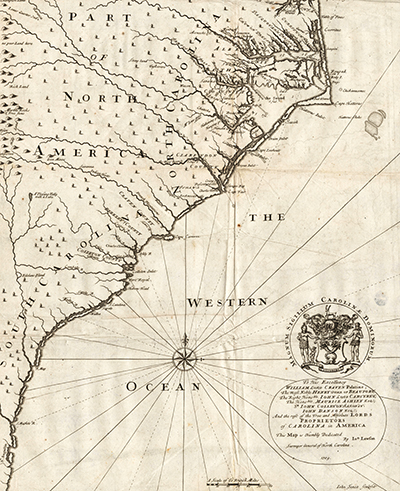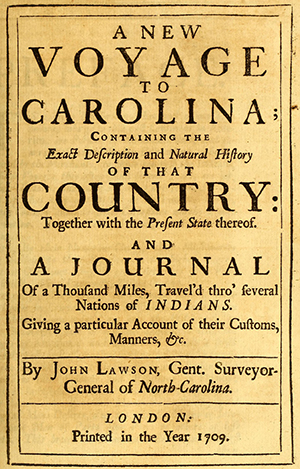27 Dec. 1674–16 Sept. 1711

John Lawson, explorer, surveyor, and author of A New Voyage to Carolina (London, 1709), was apparently the only son of Dr. John Lawson (1632–ca. 1690) and his wife [Isabella] Love (ca. 1643–ca. 1680). The father was a member of St. Bennet's Church, Gracechurch Street, London, and his mother of St. Andrew's Church, Holborn. Dr. Lawson was a grandnephew of Vice-Admiral Sir John Lawson of Scarborough, Yorkshire. The family owned estates in the vicinity of Kingston-on-Hull, Yorkshire, where it is likely young Lawson first attended Anglican schools, followed by lectures at Gresham College near the family's London residence. At Gresham an endowment supported the teaching of astronomy, geometry, physics, law, divinity, and other subjects, while the natural sciences, mathematics, inventions, travel, and discoveries were subjects of special interest. It was also the usual meeting place of the Royal Society, dedicated to the pursuit and advancement of scientific methods of developing and verifying knowledge in the natural sciences. Membership in the society was elective, based on a demonstration of merit. Lawson apparently yearned to accomplish something so notable that he would be chosen for membership.
Lawson wrote that he met with a "gentleman" who had been abroad and who was familiar with much of the New World. When questioned, he suggested that Carolina was the best country for Lawson to visit, and it just happened that there was a ship about ready to sail there. Although Lawson did not name his informant, there is evidence that it was either Christopher Gale, a native of Yorkshire and an official in the northern part of Carolina, or James Moore, from Charles Town, then in London seeking the governorship. Moore was already a friend of Lawson, and he gave him free passage on the ship that he owned which was about to sail for Carolina. Moore also became Lawson's host and introduced him to the area after they arrived on 15 Aug. 1700.
A London botanist and apothecary, James Petiver, had recently published a notice seeking someone to collect American specimens for him, and Lawson volunteered to do this without charge. Thirty of the specimens that he sent still survive in the Sloane collection at the British Museum. Lawson proved to be an unusually keen naturalist. In South Carolina, James Moore had worked to improve relations with the Indians and had won the friendship and support of many of the tribes in the southern regions of Carolina. His experience, which he discussed with Lawson, was the source of useful information.
From Charles Town on 28 Dec. 1700, Lawson set off on a 57-day swing through the backcountry of what is now the two Carolinas. Accompanied by five other young Englishmen with Yorkshire backgrounds, three Indian men, and the wife of one the Indians, he continued his horseshoe-shaped trek of around 550 miles until arriving at the Pamlico River near Bath on 24 Feb. 1701. (On 8 February, however, some of his party left and went into Virginia.) After remaining briefly along the Pamlico, Lawson built a house on some high ground near a creek, still known as Lawson Creek, about half a mile from the Indian town of Chattoka at the site of modern New Bern. He shared the house, at least for a time, with William Kirk, apparently a nephew from Portsmouth, England. From here Lawson continued to travel, among other places, to Roanoke Island, where he observed the remains of the fort built by Sir Walter Raleigh's colonists in the 1580s. He also explored the uninhabited land up to "the Ledges of Mountains" and even visited Virginia, where he called on people with interests similar to his own. He probably also went as far as Philadelphia.
In January 1707 Lawson became clerk of the court and public register of the county; in the same year he and two other men (one of whom was his friend Christopher Gale) established a gristmill. Having worked privately as a surveyor, and after 1705 as a deputy surveyor, in 1708 he became the official surveyor for the Lords Proprietors and in 1709 published a map of Carolina.
After returning from his first expedition through the Piedmont region of the colony, Lawson acquired considerable land, some by purchase and some through a grant, so he was interested in the settlement of Carolina. On 8 Mar. 1706 (new style) the Assembly incorporated the town of Bath on the banks of the Pamlico River; it was on land owned by Lawson and two other men that this first town in the northern part of Carolina was established. As a surveyor Lawson laid it out, and by late September thirteen lots had been sold.

At this time there were some 13,000 foreign Protestant refugees in and around London, many of whom were French Huguenots. Recently a colony of Huguenots had been living along the Appomattox River in Virginia in a region that did not entirely please them and they were looking for a new location. About the same time, a Swiss land company headed by Baron Christoph von Graffenried, acquired title to a large tract of land near the mouth of the Neuse River. John Lawson and his friends undertook to encourage the settlement of these assorted people in their vicinity. The land company soon engaged Lawson's services to lay out another town and make preparations for the arrival of settlers.
During his exploration of the interior of Carolina in 1700 and 1701, Lawson kept a journal. Afterwards, in whatever leisure time he had, he began to prepare it for publication as well as to add further information based on his subsequent discoveries and observations. On 9 Feb. 1709 he and others, including some officials of the colony, went to Hampton, Va., from where they sailed for England. Lawson's purpose was to arrange for the printing of the book he had written as well as to discuss with the Lords Proprietors plans for the settlement of a group of refugees in North Carolina.
Perhaps the first business attended to was the publication of his manuscript. John Stevens, veteran of James II's army in Ireland and a renowned translator, scholar, and publisher (or perhaps editor is a better term), promptly accepted Lawson's work for an anthology that he was publishing serially, entitled A New Collection of Voyages and Travels. With Historical Accounts of Discoveries and Conquest In all Parts of the World. The April 1709 issue contained the first installment of Lawson's manuscript. Stevens apparently thought so highly of it that he interrupted another continued account to rush it into print. He explained to his readers that this was necessary because Lawson would soon be returning to America. There is evidence that Lawson edited the work as type was being set.
Extra copies of the printed parts were held by the printer, and when the series was completed they were issued with a title page as A New Voyage to Carolina; Containing the Exact Description and Natural History of that Country: Together with the Present State therof. And A Journal of a Thousand miles travel'd thro' several Nations of Indians. Giving a particular Account of their Customs, Manners, &c. In 1711 Lawson's work also appeared in the two-volume compilation of Stevens's New Collection of Voyages and Travels. The printer continued to hold unbound sets of pages, and as the need arose he printed new title pages with new dates (in 1714 and 1718) and the title was changed to The History of Carolina. He simply bound up as many copies as were needed. Editions in German were printed in Hamburg in 1709 and 1722.
This work has come to be regarded as a classic of early American literature, and the detailed information it recorded of native Americans and the natural history of the region is highly treasured. Among other interesting compilations, there is a lengthy list of words in different Indian dialects. The first part of the book contains Lawson's journal, followed by separate sections devoted to a description of North Carolina geography, produce, insects, animals, and fish, and of the Indians. While nearly everything that Lawson recorded was based on his own observation, a careful reading of some of the material in The Discoveries of John Lederer and in Richard Hakluyt's Voyages suggests that he relied on the writings of Lederer, Thomas Harriot, Giovanni da Verrazano, and other explorers who preceded him to the region.
Lawson arrived back in North Carolina on 27 Apr. 1710 accompanying some three hundred Palatines to be settled in the second town that he laid out, New Bern. Von Graffenried and additional settlers soon arrived; the town developed, and farmland was cleared in the surrounding countryside. Lawson continued to work as a surveyor and explored the surrounding region. In London, the Lords Proprietors named Lawson and Edward Moseley to a commission to serve with Virginia representatives in surveying the line between Virginia and North Carolina. Several meetings were held and Lawson made some observations as to where the line should be, but no agreement could be reached.

Relations with the Indians deteriorated. They resented whites' intrusion on their hunting grounds, as well as seeing their women and children kidnapped and enslaved, and being cheated by traders. In the late summer of 1711, Lawson and von Graffenried planned a trip up the Neuse River from New Bern to try to discover its source. They hoped that it might be a waterway that would provide a route for trade with Virginia. But their expedition was halted by a large group of Tuscarora Indians who took them prisoner and held them for a time before releasing von Graffenried, thinking he was the governor. Lawson, however, was put to death. A few days later the Tuscarora launched an attack on most of the white settlements and came very close to ending the occupation of their land.
Lawson had a spouse. His will, made in Bath County on 12 Aug. 1708, referred to her in strong terms of affection and provided her with a life interest in certain real estate and personal property. He also mentioned Isabella Lawson, his daughter by "my dearly beloved Hannah Smith," and "the child or children with which she is now pregnant by me." This will was written four days after Lawson and Louis Michel, one of the new settlers at New Bern, departed from the meeting at Manakin town in Virginia at which they completed plans to sail for London the following January. Isabella, born on or about 15 Apr. 1707, was further provided for by her father. On 4 July, in her name, he bought large tracts of land totaling about 520 acres, had the deeds made directly to her, and paid for the land the same day. The child or children expected when the will was made did not survive. Isabella married John Chilley in 1727, they had children and grandchildren, and she was still living in 1790.
After Lawson's death, William Kirk asserted the role of next of kin and heir at law. He sold Lawson's house in New Bern and also detained from Lawson's executrix the personal possessions of the deceased, including a "hair trunk" with Lawson's diary and other writings.
There is a pen-and-ink sketch of Lawson made by Michel in the Burgerbibliotek, Berne, Switzerland.